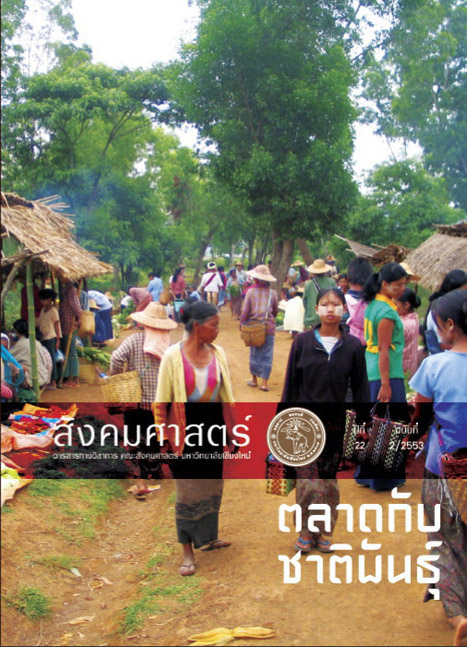Shan Food: Routes, Mobility, and Social Space in Urban Chiang Mai
Main Article Content
Abstract
This paper examines the creation of social space by the Shan people in Chiang Mai, as it relates to Shan food culture. The study considered the routes and transport of products and ingredients included in Shan food culture, as well as the consumer transactions between Shan and non-Shan people. It also considered the various actors involved in the flow, transport and production of Shan foods, and their roles in creating “spaces of inclusion” for non-Shan people to taste “other” food. The paper forwards the argument that the migration of Shan food vendors to Chiang Mai and other urban areas has improved both the visibility and access to Shan foods, while increasing their popularity and sales.
Article Details
All written articles published on Journal of Social Sciences is its author’s opinion which is not belonged to Faculty of Social Sciences, Chiang Mai University or is not in a responsibility of the journal’s editorial committee’s members.
References
นงนุช จันทราภัย และ เรณู วิชาศิลป์. 2541. “สังคมและวัฒนธรรมไตบ้านใหม่หมอกจ๋าม” ใน ฉลาดชาย รมิตานนท์ (บรรณาธิการ) ไท (285-332). เชียงใหม่: มูลนิธิโตโยต้า และศูนย์สตรีศึกษา,คณะสังคมศาสตร์ มหาวิทยาลัยเชียงใหม่.
ปณิธี อมาตยกุล. 2547. “การย้ายถิ่นของไทใหญ่เข้ามาในจังหวัดเชียงใหม่”. วิทยานิพนธ์ศิลปศาสตร์มหาบัณฑิต มหาวิทยาลัยเชียงใหม่
ปานแพร เชาวน์ประยูร.2550. บทบาทของพุทธศาสนาต่อกระบวนการผลิตซ้ำทางอัตลักษณ์ของชาวไทใหญ่ในอำเภอเมือง จังหวัดเชียงใหม่. วิทยานิพนธ์ศิลปศาสตร์มหาบัณฑิต มหาวิทยาลัยเชียงใหม่.
เรณู วิชาศิลป์. 2541. “สังเขปภูมิหลังของชาวไทใหญ่ในรัฐฉาน”ใน ฉลาดชาย รมิตานนท์(บรรณาธิการ) ไท (255-284). เชียงใหม่: มูลนิธิโตโยต้า และศูนย์สตรีศึกษา, คณะสังคมศาสตร์ มหาวิทยาลัยเชียงใหม่.
เรณู อรรฐาเมศร์. 2541ก. “ภูมิปัญญาชาวไทใหญ่กับความเชื่อและพิธีกรรม”ใน ฉลาดชาย รมิตานนท์ (บรรณาธิการ) ไท (434-448). เชียงใหม่: มูลนิธิโตโยต้า และศูนย์สตรีศึกษา, คณะสังคมศาสตร์ มหาวิทยาลัยเชียงใหม่.
----------. 2541ข. “ประเพณีพิธีกรรมชาวไทใหญ่บ้านใหม่หมอกจ๋าม” ใน ฉลาดชาย รมิตานนท์(บรรณาธิการ) ไท (333-433). เชียงใหม่: มูลนิธิโตโยต้า และศูนย์สตรีศึกษา, คณะสังคมศาสตร์ มหาวิทยาลัยเชียงใหม่.
วันดี สันติวุฒิเมธี. 2545. กระบวนการสร้างอัตลักษณ์ทางชาติพันธุ์ของชาวไทใหญ่ชายแดนไทย-พม่า: กรณีศึกษาบ้านเปียงหลวง อ.เวียงแหง จ.เชียงใหม่.
วีระพงศ์ มีสถาน. 2544. สารานุกรมชาติพันธุ์ไทใหญ่. กรุงเทพฯ: สถาบันวิจัยภาษาและวัฒนธรรมเพื่อพัฒนาชนบท มหาวิทยาลัยมหิดล.
สรัสวดี อ๋องสกุล. 2551. ประวัติศาสตร์ล้านนา. กรุงเทพฯ: อัมรินทร์ บุคส์.
เสมอชัย พูลสุวรรณ. 2552. รัฐฉาน ( เมืองไต): พลวัตของชาติพันธุ์ในบริบทประวัติศาสตร์และสังคมการเมืองร่วมสมัย.กรุงเทพฯ: ศูนย์มานุษยวิทยาสิรินธร.
สุนทรีย์ เรือนมูล. 2551. เพศสภาวะและประสบการณ์แรงงานผู้หญิงไทใหญ่ข้ามชาติในพื้นที่ตลาดสด. วิทยานิพนธ์ศิลปศาสตร์มหาบัณฑิต มหาวิทยาลัยเชียงใหม่
อรัญญา ศิริผล. 2548. คนพลัดถิ่นกับการกลายเป็นสินค้า: ประสบการณ์ชีวิตของชุมชนไทใหญ่กับการค้าแรงงานในมิติทางสังคมวัฒนธรรมบริเวณชายแดนไทย-พม่า. กรุงเทพฯ: สำนักงานกองทุนสนับสนุนการวิจัย (เอกสารอัดสำเนา).
ออมสิน บุญเลิศ. 2551. การต่อรองและปรับตัวของคนพลัดถิ่น: กรณีศึกษาชาวไทใหญ่พลัดถิ่นในเมืองเชียงใหม่. วิทยานิพนธ์ศิลปศาสตร์มหาบัณฑิต. บัณฑิตวิทยาลัยมหาวิทยาลัยเชียงใหม่.
ภาษาอังกฤษ
Amporn Jirattikorn. 2008.“Migration, Media Flow and the Shan Nation in Thailand” Ph.D. Diss., in Philosophy, The University of Texas at Austin.
Apinya Feungfusakul. 2008. “Making Sense of Place: A Case Study of Vendors and Small Entrepreneurs in the Chiang Mai Night Bazaar” in Shigeharu Tanabe (ed.) Imaging Communities in Thailand: Ethnographic Approaches (pp.107-134.) Chiang Mai: Maekong Press.
Busarin Lertchavalitsakul. 2009. “Shan Ethnic Food: The Cultural Politics of Taste in Chiang Mai City”. MA thesis, in Sustainable Development, Chiang Mai University.
Eberhardt, Nancy. 2006. Imagining the Course of Life. Chiang Mai: Silkworm Books. Forbes, Andrew and David Henley. 1997. Khon Muang: People and Principalities of Northern ThailanNew Zealand: Asia Film House.
Hughes, A. 2004.“Retailers, Knowledges and Changing Commodity Networks: The Case of the Cut Flower Trade” in Ash Amin and Nigel Thrift (eds.) The Blackwell Cultural Economy Reader (pp.210-230.) Malden, Oxford, and Victoria: Blackwell Publishing.
Kaise, Ryoko.1999.“Tai Yai Migration in the Thai-Burma Border Area: The Settlement and Assimilation Process, 1962-1997,” MA thesis in Thai Studies, Chulalongkorn University.
Mintz, Sydney. 2002. “Food and Eating: Some Persisting Questions” in Warren Belasco and Philip Scranton (eds.) Food Nations: Selling Taste in Consumer Society (pp.24-32.) New York and London: Routledge.
Pitch Pongsawat. 2006.“Border Partial Citizenship, Border Towns, and Thai-Myanmar Cross-Border Development: Cases Studies at the Thai Border Towns”, Ph.D. Diss., in City and Regional Planning, University of California, Berkeley.
Sada, P.O. et al. 1978.“Periodic Markets in a Metropolitan Environment: The Example of Lagos, Nigeria” in Robert H.T. Smith (ed.) Market-Place-Trade: Periodic Markets, Hawkers, and Traders in Africa, Asia, and Latin America (pp. 155-166.) Vancouver: The Center for Transportation Studies, University of British Columbia.
Stoller, Paul. 2004. “African/Asian/Uptown/Downtown” in Ash Amin and Nigel Thrift (eds.) The Blackwell Cultural Economy Reader (pp.193-209.) Malden, Oxford, and Victoria: Blackwell Publishing.
Tannenbaum, Nicola. 1995. Who Can Compete Against the World?: Power Protection and Buddhism in Shan Worldview. Michigan: The Association for Asian Studies.
Yasuda, Sachiko. 2008.“Shan on the Move: Negotiating Identities through Spatial Practices Among Shan Cross-Border Migrants in Northern Thailand”, MA thesis, in Sustainable Development, Chiang Mai University.


